9 Ways to Drastically Improve Front Door Security
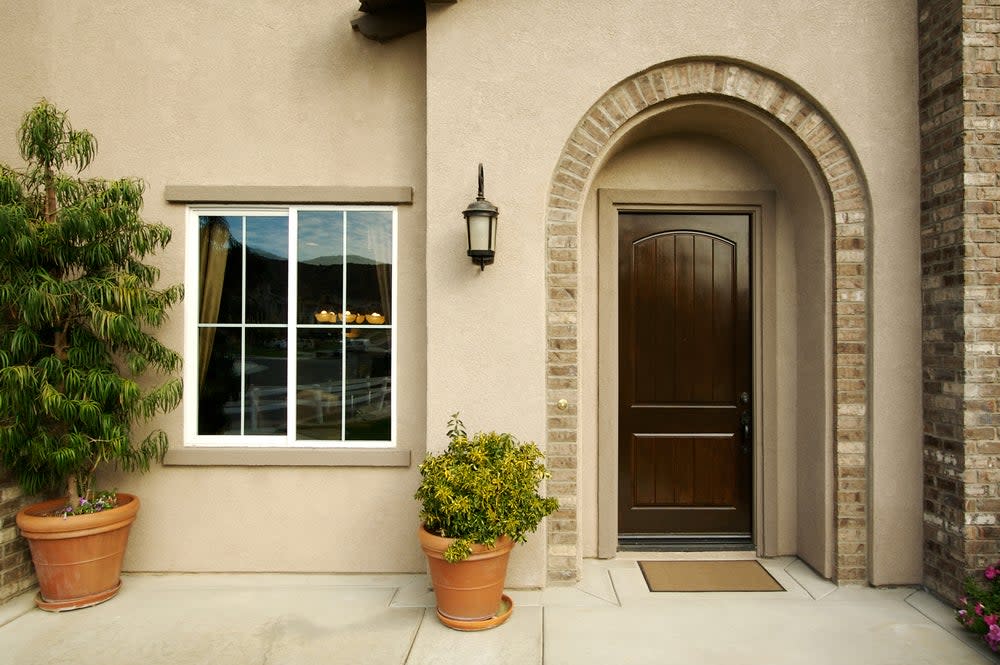
Countless articles on decorator websites focus on curb appeal, encouraging homeowners to choose this color to stand out, or pick that one so their home can blend attractively into the surrounding neighborhood and landscape. However, the front door is also the most obvious entry to a home, and if it’s not secured, it only takes a moment for a burglar to muscle in through the door and gain access to everything (and everyone) inside. In the past, security for a front door meant bulky security door locks and heavy, unattractive doors that made homes feel more like fortresses, but modern options take steps to increase front door security while staying stylish.
Before You Begin...
To start, it’s a good idea for a homeowner to assess their current level of front door security. Is the door new? Solid-core? Older wooden doors can succumb to damp or dry rot, making them vulnerable to being kicked in.
The next consideration is the door’s locking mechanism. Ideally, a front door will be secured with a strong deadbolt into a sturdy door frame and have a high-level security lock—or better yet, a doorbell camera with two-way voice communication. It’s also worth considering smart locks and a security system that works with the current smart-home features.
Homeowners will want to carefully consider how many security cameras they need as well as any sensors or alarms that may be useful. Most of these potential upgrades are simple for experienced DIY-inclined homeowners to install, but for those who aren’t certain they can do the job, it may be time to call in assistance.
STEP 1: Lock your front door.
It may sound obvious, but the single most important thing a homeowner can do to make their door a solid obstacle to an intruder is to lock it every single time they leave, even just for a quick walk around the block. An unlocked door is an intruder’s wildest dream. If it’s a challenge for a homeowner to remember to lock the door, a keyless lock is an excellent option. Some smart locks even include reminders if the key fob travels too far from the base unit without locking it.
Intruders are well aware that many homeowners keep a spare house key handy under their doormats or in the mailbox. Instead, homeowners will want to leave spare keys with a trusted neighbor or find more hidden locations to tuck them away. Another advantage of keyless door security locks is that homeowners can remotely let in guests, repair and maintenance workers, or pet sitters without leaving spare keys out for potential intruders to find.
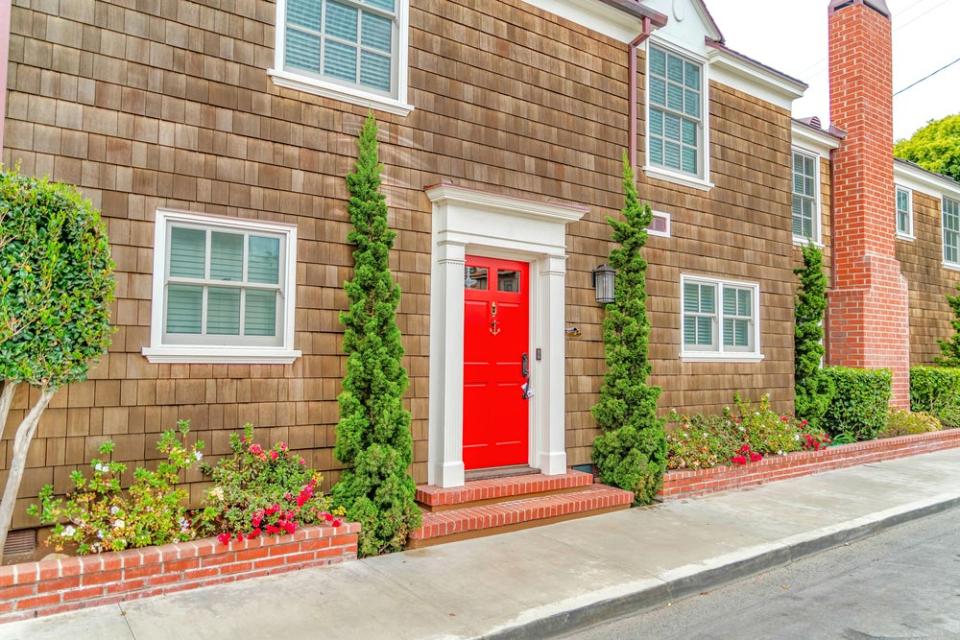
Photo: depositphotos.com
STEP 2: Rekey your lock or replace it completely.
When moving into a new home, homeowners will want to have the locks rekeyed or replaced as soon as possible. That’s because whoever lived in the home previously may have handed out keys to friends and relatives who may not realize that someone new has moved in. A home is not secure if strangers could potentially have access to it. A good locksmith can make new keys and shift the tumblers in the lock to match.
“I recommend changing or rekeying locks after major events in someone’s life, like getting married or having a baby, because we tend to forget who all in our lives [has] keys to the home, and this can lead to security issues,” says Kirk MacDowell, a home security expert at Batten Safe and CEO of MacGuard Security Advisors in Lake Oswego, Oregon. Many copies of the house key have likely been handed out to contractors, friends, and neighbors over the years. Additionally, a lock’s tumblers can wear out over time and become less secure. Rekeying the locks periodically can help ensure homeowners know exactly who has access. This may also be a good time for a homeowner to consider other types of door locks, such as smart locks. “If you have an electronic lock, you can change it anytime you want, and some even allow you to set up personal or one-time codes for guests and family,” MacDowell adds.
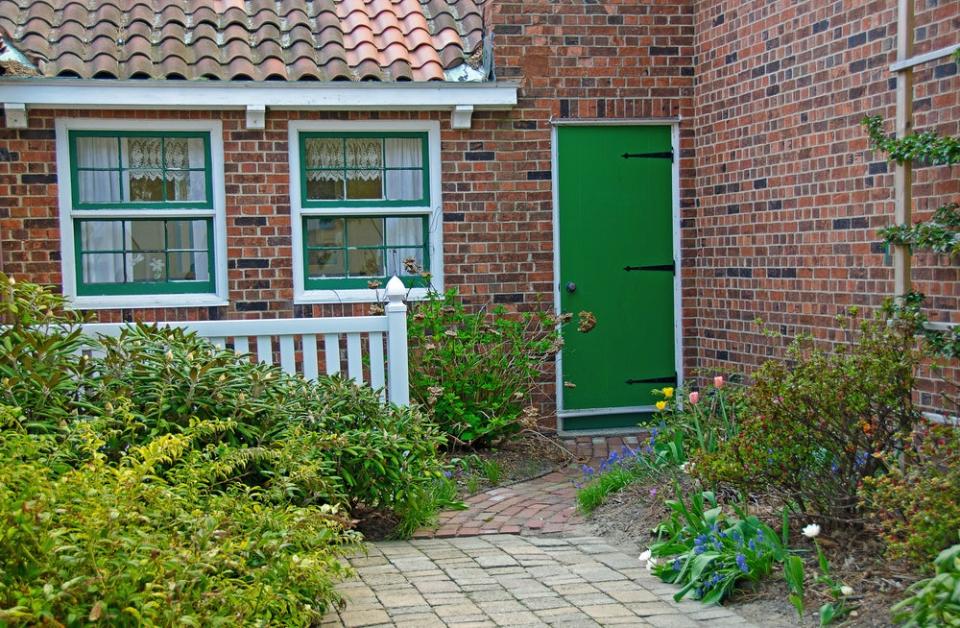
Photo: depositphotos.com
STEP 3: Install a solid-core door and a security screen door.
Many older homes feature wood doors that have begun to rot or split, and simply don’t have the strength to withstand a sharp kick or shove. Hollow-core doors, which are really intended for indoor use, are also a huge liability when installed in an exterior entryway, as are older doors with large panes of glass.
One of the best ways to secure a door from being kicked in is to replace it with a security door. There is a wide array of styles among security doors, making it easy to find one that suits the aesthetic of the home. For security purposes, a solid-core door will need to be made of wood, steel, or even fiberglass with a wood core. Steel security doors are some of the strongest doors available and are difficult to crack or break, and solid wood and fiberglass options aren’t far behind.
For an added layer of protection, homeowners may want to consider replacing a full-view glass or screen storm door with something a little heftier. Front door security screens and security storm doors provide an additional barrier between an intruder and the front door, and they are also available with decorative designs. Plain metal screen doors or metal security doors can also add security, but they’re less likely to add style. Adding security screen doors can go a long way toward making a front door more secure.
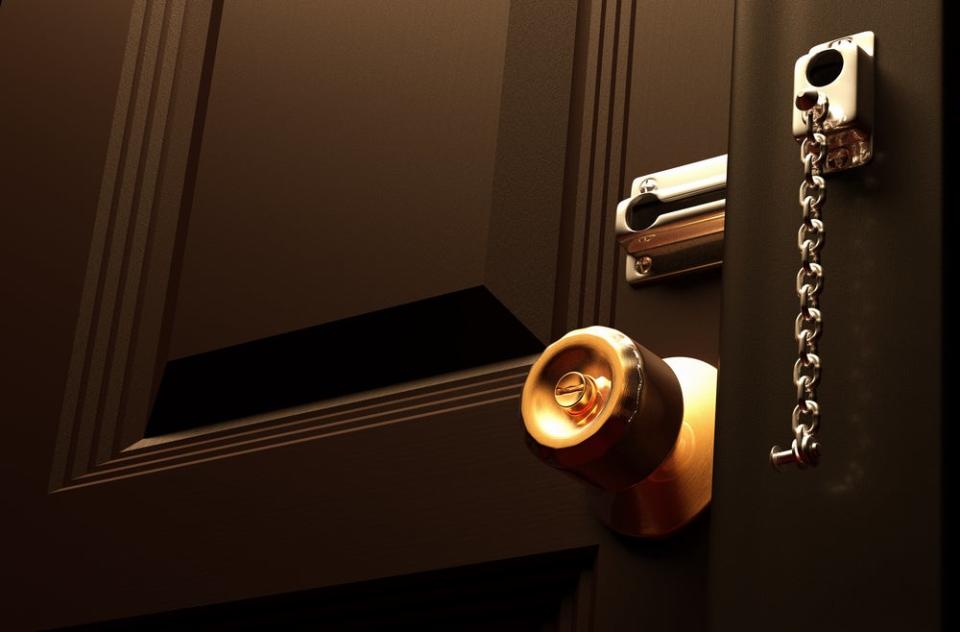
Photo: depositphotos.com
STEP 4: Replace the door frame, hinges, and strike plates if they show signs of wear.
A front door is only as secure as the frame, hinges, and strike plates that accompany it. Door frames are exposed to weather and heavy daily use. If the door frame is older or showing signs of wear (such as splitting or cracking), it’s time to replace it. Replacing the whole door makes it possible to choose one that is pre-hung in a new frame. This will make the door easier to install correctly. There’s also the option to rebuild the door frame using lumber from the home improvement store. To reinforce the frame, homeowners will want to consider choosing a door jamb reinforcement kit, which will include a metal reinforcement piece to make the door more difficult to wrench out. According to MacDowell, “The door jamb is as important as your lock. In my experience, there have been many times I have seen a door completely kicked in or destroyed but the lock is still intact. So, homeowners should install and enforce a strike plate that will increase the stability of the door jamb.”
A strike plate is a metal plate that protects the part of the door frame where the latch sits when the door is locked. Many strike plates are installed with cheap, short screws that are easily yanked out when pressure is put on the locked door. Homeowners who are handy with a screwdriver can easily replace the existing screws with screws that are at least 3 inches long. Hinges that are located on the outside of the door are another weak point. If it isn’t possible to move hinges to the inside of the door, it’s a good idea to reinforce them with hinge guards so an intruder can’t just pop them free. Adding these components to the existing or new door frame will make the weakest points of the door far more secure.
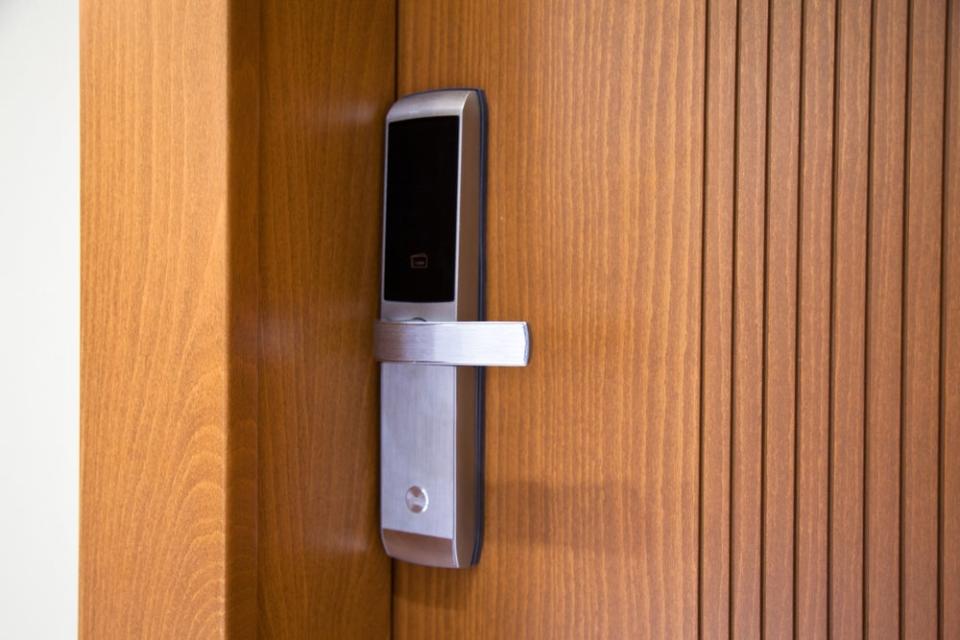
Photo: depositphotos.com
STEP 5: Install door reinforcements.
Many doors include a handle set with a twist or push-button lock in the handle. These types of locks are nice as backup but can easily be defeated by a quick kick or punch from someone trying to get in. They simply don’t have the mass to keep the door closed under pressure. For that, it’s a good idea for a homeowner to install a single-sided deadbolt. Deadbolts can only be accessed from the inside, so even if an intruder is successful in picking the outer lock, the door will remain secure.
Many homeowners choose to install additional front door security locks like a door chain, which makes it possible to open the door a few inches to engage whoever is outside in conversation without giving them free access to the home. Adding a door chain may be especially helpful to renters—a chain helps prevent others from accessing the apartment, even if the person trying to enter has a key.
Other door security devices to consider include strike plate locks, which function similarly to a chain. “Some other options are to install a door alarm or a doorstop that is installed from the inside,” MacDowell adds. The best front door security bars or jammer bars are a way to secure a door without a lock or add an extra layer of protection.
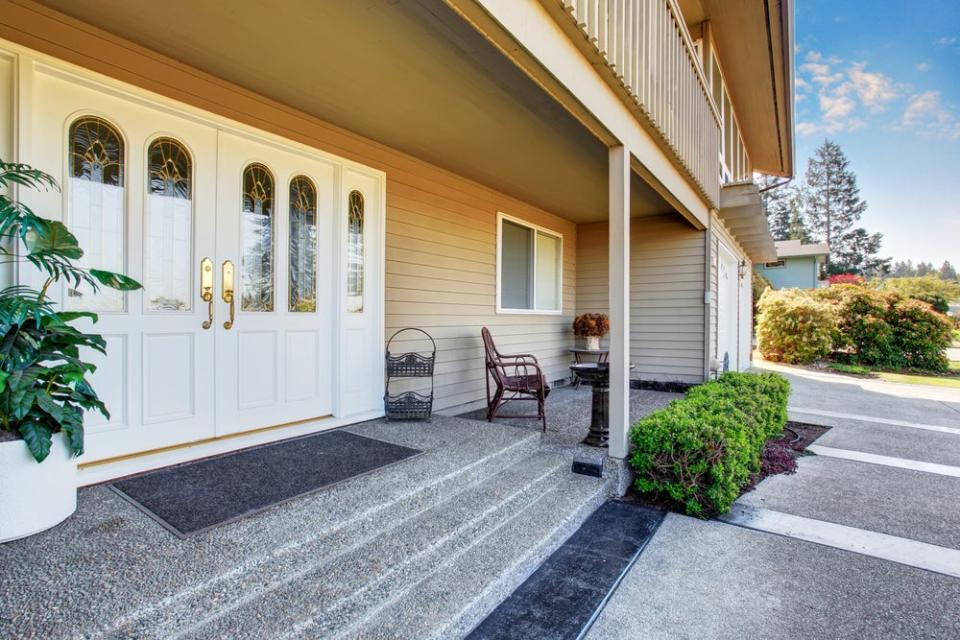
Photo: depositphotos.com
STEP 6: Install a wide-angle peephole to identify visitors before answering the door.
Some intruders will take the moment a door opens as an opportunity to force their way inside after surprising an unsuspecting homeowner. A peephole allows residents to see who is at the door so they can safely decide whether or not to answer it. While many apartment doors already come with a peephole, on a house it may be necessary to have one installed. Wide-angle peepholes are the best choice, as they make it possible to see if someone is standing a few paces away from the door in an attempt to hide. The existence of a peephole can even act as a deterrent against intruders who may decide to search instead for a home without one.
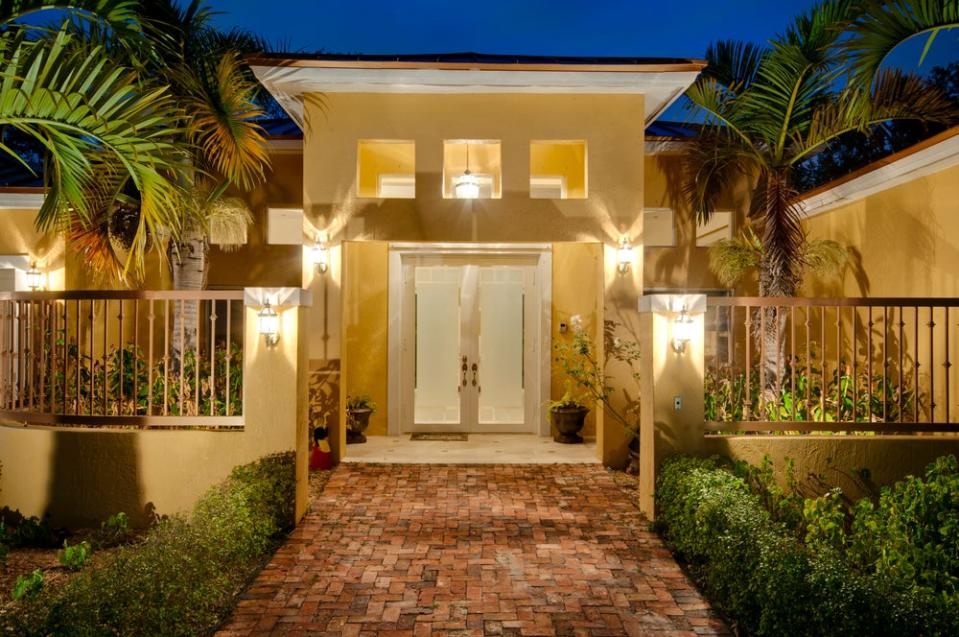
Photo: depositphotos.com
STEP 7: Reinforce any glass in the door.
Glass panes in front doors add a decorative element to the home, as well as letting in lots of natural light. But they could also allow an intruder to smash them, reach through, and flip open the deadbolt. Then the intruder can simply stroll inside. The best way to secure a door with a lot of glass is to replace it with a solid door.
If that’s not practical, security film is a subtle way to secure windows without bars. Made of thin vinyl and available either in clear or translucent frosted styles, security film is applied carefully to all the glass in the door, and once set will bond with the glass. Should someone try to smash in the glass, the film will work like the anti-shatter coating on automobile windows: the glass pieces will crack but stick firmly to the film, which will not give way easily. The intruder will be forced to shove their hand through a wall of sharp, shattered glass to try to get to the deadbolt, which makes injury very likely and may cause the intruder to retreat. Frosted film (which is available in plain translucent or decorative geometric or floral patterns) also works to blur or partially conceal what is behind the door, which will make it more difficult for an intruder to see if anyone is home or to view any valuables in sight of the front door. It’s also a good idea for homeowners to put up blinds or curtains for more privacy.
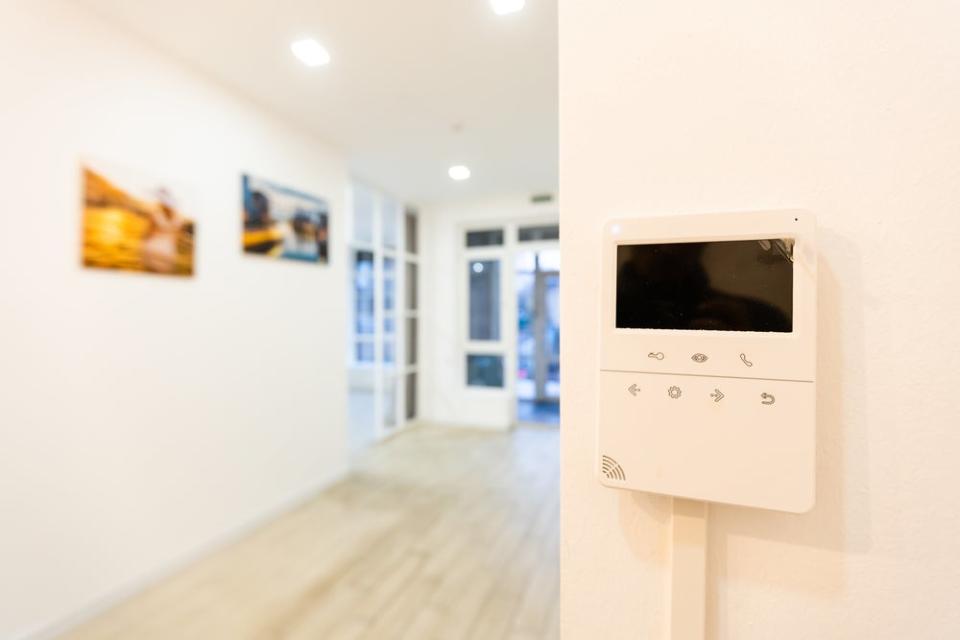
Photo: depositphotos.com
STEP 8: Keep the area around the front door well lit and visible.
Darkness is a stealthy intruder’s friend; it provides cover and hides them from immediate discovery. Homeowners can consider improving the basic door lighting by adding fixtures, cleaning the glass surrounds on existing lights, and increasing wattage. Those lights can also be connected to light sensors or a smart-home system that automatically turns them on at dusk and off at dawn, saving homeowners the trouble of remembering to leave porch lights on at night. Well-lit interiors also suggest that someone is home and that residents may still be awake and moving around the house.
Motion-sensor lighting can add additional visibility to the front yard. These lights can be programmed to respond to different levels of motion, which is important. If the sensors are too sensitive, they’ll turn on every time a cat stalks through the yard, which can make them easy to ignore. These lights will ideally focus on the door and any dark or obscured areas surrounding the doorstep so that they can draw immediate attention to anyone who is close to the home without good reason. For those who plan on installing security cameras, it’s also important to make sure that the area the camera is trained on is well lit enough to capture potential activity.

Photo: depositphotos.com
STEP 9: Install a home security system and opt for professional monitoring.
Home security systems often deter criminals from approaching a home to begin with (security signs are one of the most effective things to leave at the front door to stay safe). Given a choice between a home with obvious indicators of a security system and one without, burglars will generally choose the less secure home. The best home security systems (like Vivint or ADT) also offer a wide range of equipment options (and for those who would like to save on security camera installation costs, there are plenty of DIY systems on the market). According to MacDowell, noise matters, so some of the most effective equipment options are “a doorbell camera or a camera that emits a tone that lets people know they’ve been seen.” Many video doorbells can give the illusion that someone is home when no one is and also make it possible to screen a visitor without opening the door. It’s also worth installing at least one additional front door security camera outdoors that can help cover any spots that aren’t visible via the video doorbell. In addition to cameras, door and window alarm sensors alert homeowners anytime the door or window is opened. For front doors with glass features, glass-break sensors are another option that will alert homeowners to the sound of glass shattering.
Many homeowners choose self-monitored home security systems because they seem easier and less expensive, but professional monitoring offers several advantages. A self-monitored system sends an alert when someone is approaching or is trying to break in, but it can’t call for law enforcement help. A professionally monitored system can handle that part while homeowners focus on making sure they and their families are safe. Plus, the best homeowners insurance companies, like Allstate and Lemonade, often offer a discount for home security systems that are professionally monitored.
With a small investment in some supplies and reinforcement, a little time, and some research on where to place security cameras, a front door can welcome guests and stand firmly and solidly in the way of unwelcome intruders.
